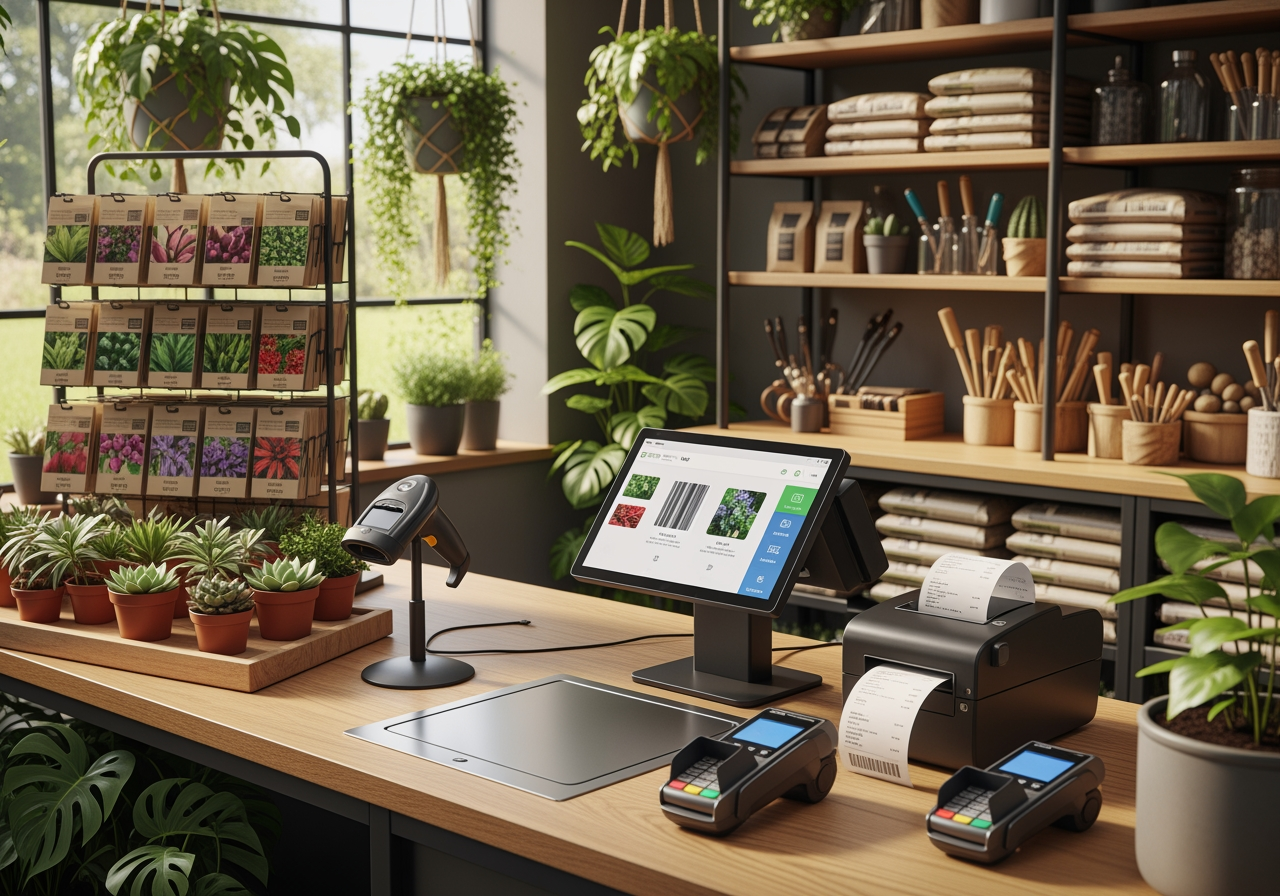Thrift businesses deal with donated or secondhand goods, unique inventory, and consignor payouts, so the system must handle more than simple barcode scanning. A good POS should help you organize inventory with ease, track sales accurately, and simplify payouts or donations without slowing down checkout. How to choose a thrift store POS? This guide will walk you through what to look for to choose a POS with confidence.
Highlights
- Selecting a scalable POS ensures your thrift store can grow into online sales or multi-location operations without switching systems later.
- Key features to prioritize include item tagging, dynamic pricing, reporting, multi-channel selling, and ease of use for staff and volunteers.
- Avoid common mistakes such as choosing a generic retail POS, skipping workflow testing, or ignoring reporting and mobile selling needs.
What Makes a POS System Necessary for a Thrift Store?
A thrift store POS can manage both donated and consignment items efficiently. It keeps track of donated goods separately from consigned inventory, records consignor information, calculates revenue splits, and generates clear payout reports. This ensures transparency and accuracy for stores that rely on multiple sourcing methods.
Most modern thrift POS systems also support mobile checkout, which is useful for pop-up markets, community events, or off-site donation drives. Staff can process sales using tablets or smartphones, making it easy to serve customers outside the main store location and increase revenue opportunities.
Pricing second-hand items is rarely uniform, so a good thrift POS includes flexible pricing tools. You can set prices based on condition, category, or color tags, and apply scheduled markdowns to older inventory. Automated discount rules help maintain consistent pricing without extra manual work.
Key Features to Look For in a Thrift Store POS
A part of “How to choose a thrift store POS?” is knowing the essential features of an effective system that can support your business.
Check out the list below.
- Inventory and Item Tagging/Labeling
Thrift stores receive a wide mix of products, many of which are one-of-a-kind. A strong POS lets you create item entries fast, add product descriptions, apply condition-based pricing, and print labels or tags.
- Dynamic Pricing and Discounting
Pricing in thrift stores changes often. Look for features that support color tag discounts, weekly markdowns, or custom promotion rules.
- Donation or Consignment Management
Many thrift stores accept both donated and consigned items. Your POS should track consignor agreements, item ownership, and revenue splits. It should also generate payout reports and maintain donor history for accountability and recordkeeping.
- Sales Channels and Checkout Flexibility
Thrift stores are expanding beyond brick-and-mortar. A flexible POS should support in-store checkout, mobile selling at events, and even eCommerce if you list selected items online.
►►► Optimal solution set for businesses: Multi store POS, Next-gen POS, Inventory Management Software (MSI), Self Service, Automation, Backorders
Useful reports include inventory turnover, best sellers, product aging, and staff performance. Donor impact reports are helpful, too, for nonprofit thrift stores that want to share results with supporters.
- Payment and Donation Processing
Your system should accept multiple payment methods such as cash, credit cards, and digital wallets. It is also helpful if it allows shoppers to round up for charity or add small donations during checkout.
- Ease of Use and Training
Thrift store teams often include volunteers or part-time staff. An intuitive, clean interface reduces training time and helps staff get productive quickly.
How to Choose A Thrift Store POS?
Each store runs differently, so the best system is the one that matches your daily tasks and long-term goals. Begin with a list of must-have features based on how your store operates and how you plan to grow.
- Identify your daily needs – Write down the specific functions you rely on, such as donation intake, consignment tracking, markdown schedules, or pop-up event sales.
- Check hardware and budget – Make sure the POS works with your current receipt printers, scanners, and cash drawers. Set a realistic monthly or annual budget before comparing systems.
- Request demos and test real workflows – Do not rely on brochures alone. Ask for a live trial and test real scenarios like intake → tagging → sale → payout to see if the system fits.
- Review total cost – Look at software fees, hardware costs, and payment processing rates. Some POS providers also charge extras for advanced features, so read the pricing details.
- Evaluate support and training – Reliable customer support and onboarding help are important, especially for stores with volunteers or new staff.
- Choose a system that can grow – Pick a POS that supports upgrades, multiple stores, or online sales, so you do not have to switch again later.
Common Mistakes to Avoid When Selecting A Thrift Store POS
These errors often lead to extra costs, wasted time, and a system that does not support daily operations.
- Picking a standard retail POS – A generic system may look affordable, but it often lacks tools for donations, consignments, and used products.
- Ignoring intake and tagging workflows – Thrift inventory is rarely uniform. If a POS cannot support quick labeling, pricing by condition, and category sorting, it will slow you down.
- Skipping staff training – Choosing a system that seems simple and assuming everyone will figure it out leads to mistakes. Training matters.
- Overlooking mobile selling – Many thrift stores join pop-up markets or community sales. If the POS does not support mobile checkout, you lose sales opportunities.
- Neglecting reporting tools – Without insights into best sellers, aging stock, and profit margins, decisions become guesswork.
How ConnectPOS Can Support Thrift Stores And Resale Shops
ConnectPOS is designed to support retail models that operate outside of traditional inventory rules, which makes it a strong fit for thrift stores and resale businesses. Key advantages of ConnectPOS include:
- Support for unique inventory – Manage single-quantity items, categorize used goods, and apply pricing based on condition without hassle.
- Flexible pricing and discount tools – Set up rotating markdowns, seasonal sales, or color-tag discount schedules with ease.
- Real-time stock sync and tagging – Create custom product tags, track item sources, and sync inventory across locations or online stores instantly.
- Smart reporting and analytics – View dashboards that track fast movers, slow stock, profit margins, and inventory aging to make confident decisions.
- Built for growth – ConnectPOS works for brick-and-mortar, online resale, or multi-location expansion.
- Mobile POS for pop-up sales – Sell at events or markets with mobile checkout features.
- Integrated payments – Accept secure payments through various gateways and keep processing fees manageable.
FAQs: How to Choose A Thrift Store POS
Can a thrift store POS manage both donated and consignment items?
Yes. A thrift store POS is designed to handle mixed inventory models. It can track donated items separately from consigned stock, record consignor details, calculate split payouts, and generate reports for accounting and transparency.
Does a thrift store POS system support mobile checkout or pop-up events?
Many modern thrift POS systems support mobile checkout using tablets or smartphones. This is ideal for pop-up events, donation drives, mobile sales, and community markets.
How does pricing work for thrift store items in the POS (e.g., markdowns, age of item)?
Thrift store POS systems often include dynamic pricing features. You can assign prices based on tag colors, item condition, or category.
How quickly can staff be trained to use a new POS in a thrift store environment?
Training time depends on the system’s interface, but most thrift-ready POS platforms are beginner-friendly. Staff and volunteers can usually learn basic functions in a few hours.
To Conclude
Now you know “How to choose a thrift store POS?” With the right tools, you can manage unique inventory, streamline donation or consignment processing, speed up checkout, and gain better insight into your business performance. ConnectPOS offers the features thrift and resale businesses need, so you can focus on what matters most: delivering value to your customers and supporting your mission.
Have more questions? Contact us today for a free consultation and product demo!
►►► Optimal solution set for businesses: Shopify POS, Magento POS, BigCommerce POS, WooCommerce POS, NetSuite POS, E-Commerce POS



